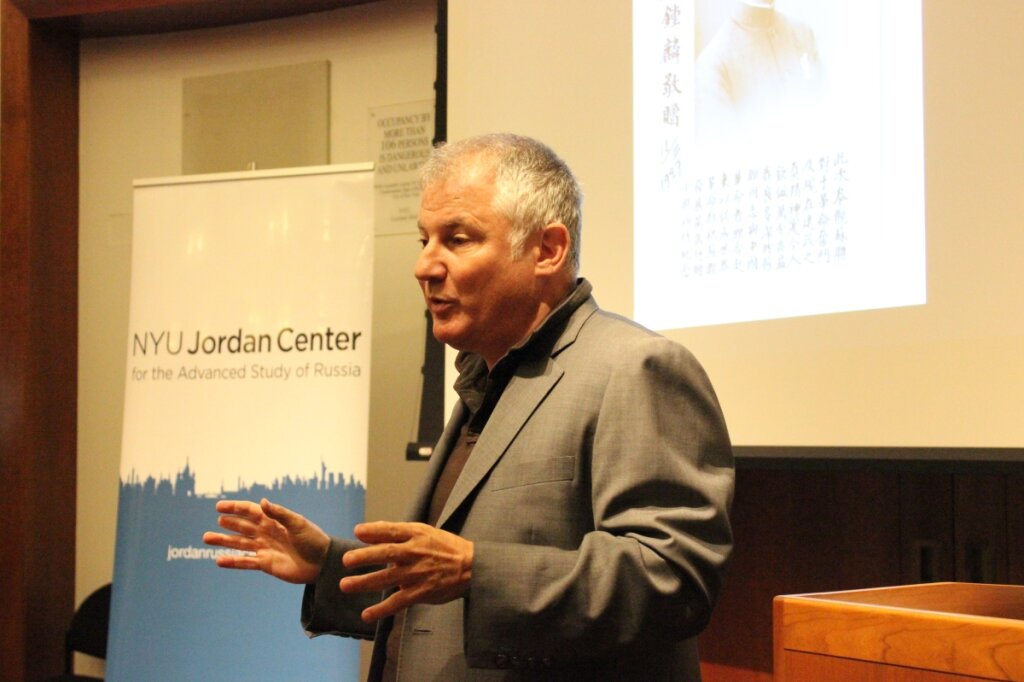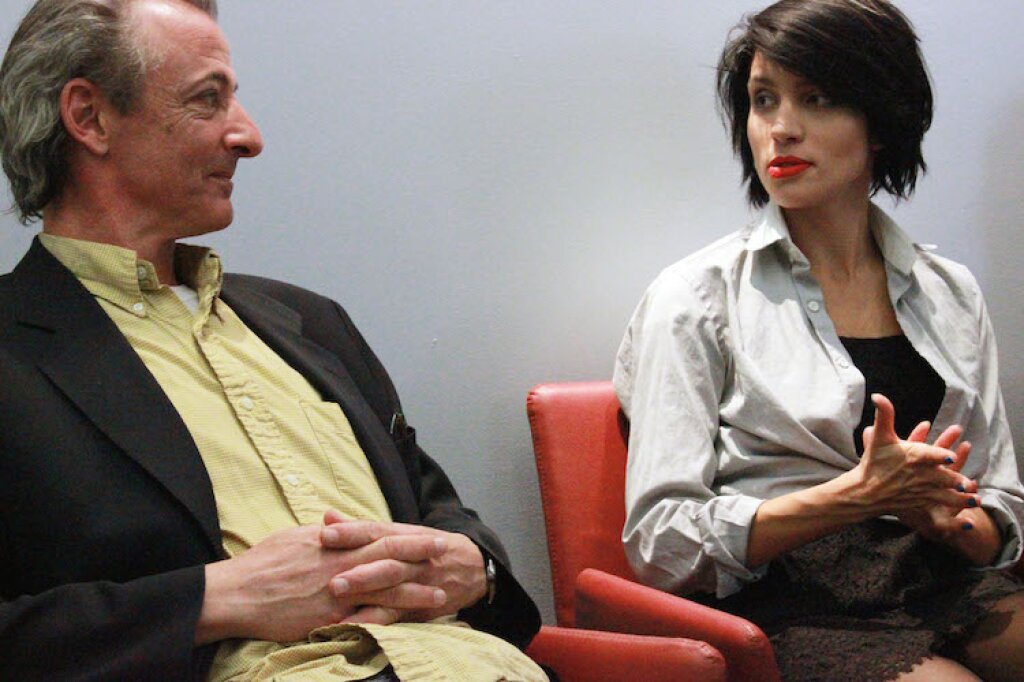Watch the video of the event here
September 26, 2014, marked the first Distinguished Lecture at the Jordan Center for the Advanced Study of Russia. As director Yanni Kotsonis pointed out, the lectures as well as the Center itself are meant to “protect conversations about Russia. If one wants to speak for Russia these days, you need protection; if one wants to speak against, you also need protection.” He added: “The only criterion here is intelligence.”
The Center’s first distinguished guest was Stephen Kotkin – a renowned historian of the Soviet Union who holds appointments at Princeton University in the Department of History and the Woodrow Wilson School of Public and International Affairs. Kotkin began producing scholarship on the Soviet Union at the end of the 1980s, when, as Kotsonis pointed out in his introductory remarks, “we needed to rethink what it was and where it was going.” He also ironically remarked that since then, Kotkin “was able to produce ‘modest’ scholarship on ‘modest’ subjects” such as Stalinism, the end of the Soviet Union, and the transition to post-Communist order. After Kotsonis’ brief introduction of the scholar’s publications and ways in which each of them strongly influenced and transformed Soviet historiography, Kotkin delivered an enthusiastic, engaging and – despite the gravity of the subject matter – at times humorous lecture to a capacity crowd of over one hundred people in Jurow Hall at NYU’s Silver Center.
Kotkin’s talk drew on his most recent project – the first volume of a trilogy on Joseph Stalin’s life that will be available in print this November. The first volume sets up the historical context around the time of Stalin’s birth and concludes in 1928. The second volume is expected to come out next year. What is truth and what is fiction in the many writings on Joseph Stalin’s life? What forces and circumstances shape and determine the psychology of the political dictator like Stalin? Should external geopolitical and historical forces take precedence over personal biographical facts in an attempt to understand the actions of world leaders and the motivations behind them? These are some of the questions that Kotkin addressed in his lecture and in his “modest” publication.
Kotkin began his talk by remarking: “Let me explain why one would do something like this: everyone of us eventually thinks that they will write a book on Stalin and about 50% of us do.” Why did he feel that an extensive project like Stalin’s biography was feasible for him? Much had to do with the availability of resources, he stated. While the KGB archives in Russia still remain largely classified, the Hoover Institute and the Library of Congress nevertheless acquired 55 microfilms of military and police documents. The Presidential archives had also been declassifying their documents until about three years ago. The author noted that these were the most crucial documents to his project because Stalin’s regime was “a police and military dictatorship.” Upon recognizing the richness of materials available to him, Kotkin was convinced that this was a feasible project.
Kotkin moved on to discuss what is said and what is not said in his book. He stated that much of what is written about Stalin, even by respected historians, is not true. The reason for this, he explained, is the abundance of untrustworthy documents: “The regime is lying and Stalin’s enemies are blackening him. That combination creates a record that is really unreliable.” In particular, Kotkin remarked, Stalin’s childhood often remains obscured due to a collection of documents produced in Tbilisi, in which Lavrentiy Beria invents a fantastical chronicle of Stalin’s early life in an attempt to flatter the dictator. It is these materials that remain the main source for researchers of Stalin’s early biography (e.g. Simon Montefiore).
So “how do you deal with his early life if you don’t want to invent his early life, however sexy that might be?” Kotkin asked. He believes that much more useful than using the available murky materials about Stalin’s childhood is to outline the historical and geopolitical context during which Stalin was coming of age. “Geopolitics are the primary movers of history,” Kotkin added with ardor. In the decade that Stalin was born, the unification of Bismarck’s Germany and the Meiji Restoration in Japan ruptured the historical trajectories of 19th century, after which one could no longer do politics the same way as before. Modernity is “a brutal, unsentimental race” in which modernized nations put the pressure on others to modernize, or else become subjugated by them. Russia was in this race for modernity. “You cannot defeat modernity with nothing,” Kotkin proclaimed, “You can only defeat modernity with modernity. And it is not enough to catch up. It is constant. And the pressure is incredible.” From this perspective then, the Russian state was a success, not a failure. It managed to mobilize resources and to compete under this brutal pressure. However, he added, Russia had a fatal flaw: “its state is not pretty but it is functional, the autocracy is not.” This is the world that Stalin was born into, Kotkin stated, and the world that he was going to change. A large portion of Kotkin’s first volume on Stalin focuses on this preamble to Stalin’s own story.
The book also attempts to make sense in a chronological order of Stalin’s rise to power and the consolidation of the regime, which was absolutely unforeseeable in the early post-Revolutionary years. Kotkin believes that his book might add a new dimension to Stalin’s psychological character. On the one hand, the book presents him as a shrewd and calculating opportunist who schemed his way into having unlimited constitutional power. “History is about people who seize opportunities that they did not create and then move them in some direction that benefits themselves. They seem to ride history,” Kotkin asserted. However, the book also reveals that Stalin was an anxiety-ridden dictator who was often confronted with situations pointing to the limits of his control.
By 1922, Kotkin stated, it is clear that Stalin is already a dictator: “He did not cause Lenin’s first stroke, but of course he seized that opportunity.” After he is appointed Secretary General, Stalin immediately begins to ensure complete constitutional power; he not only exerts power on the military through the Party apparatus but also very energetically builds the Party apparatus vis-à-vis the police and the military. “Everywhere he finds not only an agent, but also an enemy of the agent.” In other words, in a calculated manner Stalin set up relationships of enmity that he could later draw upon.
But while he built his way to the level of unlimited power, Stalin faced situations that revealed the limits to his power and caused much anxiety. For example, Kotkin placed a lot of emphasis on the mystery behind the letter that Lenin supposedly dictated in 1923 (the so-called Testament), in which he proposed to remove Stalin from the position of General Secretary. The author revealed that, to his surprise, he could find no proof that this document was dictated by Lenin. “It is impossible to say.” It is also impossible to say whether Stalin thought that the Testament was a fake or not. But his unpredictable and anxious behavior seems to suggest a degree of uncertainty. Returning to the subject of Stalin’s murky childhood, Kotkin claimed that all of the unreliable information about Stalin’s abusive childhood is no longer necessary to explain his warped psychology. The combination of having unlimited power but simultaneously worrying over Lenin’s opinion could have affected his psychological character.
The other important aspect of Stalin’s vulnerability was the capitalist encirclement and the economic deterioration of the state at the time of the consolidation of his power. Kotkin stated: “The regime was beginning to close off its options. It was beginning to wound itself. It was mismanaging itself.” At the time Stalin was facing pressure and expectation from the rest of the Party to salvage the situation. Kotkin showed that Stalin’s actions were at times improvised and reflexive, later adding that we have to “remember that Stalin is a screw-up – he is screwing up left and right. […] He does not understand a lot of things. His knowledge, his blinkers, his worldview cannot understand a lot of the world. We don’t want to present him as a genius. We have to be careful how we interpret his skills.” Yet, Kotkin revealed that once Stalin set out to change the rules of the game, he was relentless. Kotkin emphasized the importance of his trip to Siberia in January of 1928, during which he decided to collectivize the agriculture to procure more grain. According to the historian, this is a primary early example of impromptu decision-making and its subsequent relentless implementation. The talk concluded by discussing similar mechanisms at work behind Stalin’s “Shakhty” trials.
The main mystery of the book, Kotkin added, is the question: “where does the power come from?” How does one person rearrange the whole social base? Yet, at a different time in his lecture, following his usual scholarly trajectory, he transferred agency from a singular dictator to the level of society: “This is what people don’t understand. They think that society is outside the state. But the gangster regime is also the society. This book is about power in terms of the regime being the society.”
Several questions followed Kotkin’s presentation. The first few, including one raised by Professor Jochen Hellbeck of Rutgers, dealt with the ideological positioning of Stalin’s regime. Did Kotkin see the state as a Marxist one, and does Marxism explain Stalin and the USSR? To these questions Kotkin replied positively. Stalin believed that he was following Lenin’s writings that stated that all means are fine in defense of socialist revolution. Nothing is immoral. Kotkin added: “It is clearly a self-conceived Marxist regime.” The dominating Marxist vocabulary, he believes is “not a means to an end. Not a symbolic language. It is how they think. It is a worldview.” Kotkin exclaimed somewhat rhetorically. Certain options were foreclosed. “Does anyone make statements that we were wrong and we don’t have to transcend capitalism? Can you point to any internal documentation that accepts the market? If you look at Bolshevik discussions, find me pro-market, pro-capitalist, pro-bourgeoisie statements uttered by anybody!”
Another interesting question, raised by Jane Burbank of NYU, is whether any analogies can be drawn between the Soviet and the Tsarist regimes. Kotkin replied that he is not a political analyst, but a historian, and therefore it is difficult for him to discuss such broad political mechanisms. However, the main difference that he perceives between the two regimes is “that the Soviet regime was not afraid of modernity.”
One of the final questions was raised by Professor of Russian Studies at NYU Stephen Cohen: “What is Stephen Kotkin’s Stalin?” To which Kotkin responded: “I will let readers answer that question.” He continued, stating that he does not interpret beyond documentation. “I have a feeling that there will be several Stalins for the readers of this book.” To form your own interpretation of Stephen Kotkin’s Stalin, follow the advice that he repeatedly offered during his talk: pre-order your own copy of Kotkin’s Stalin online.



